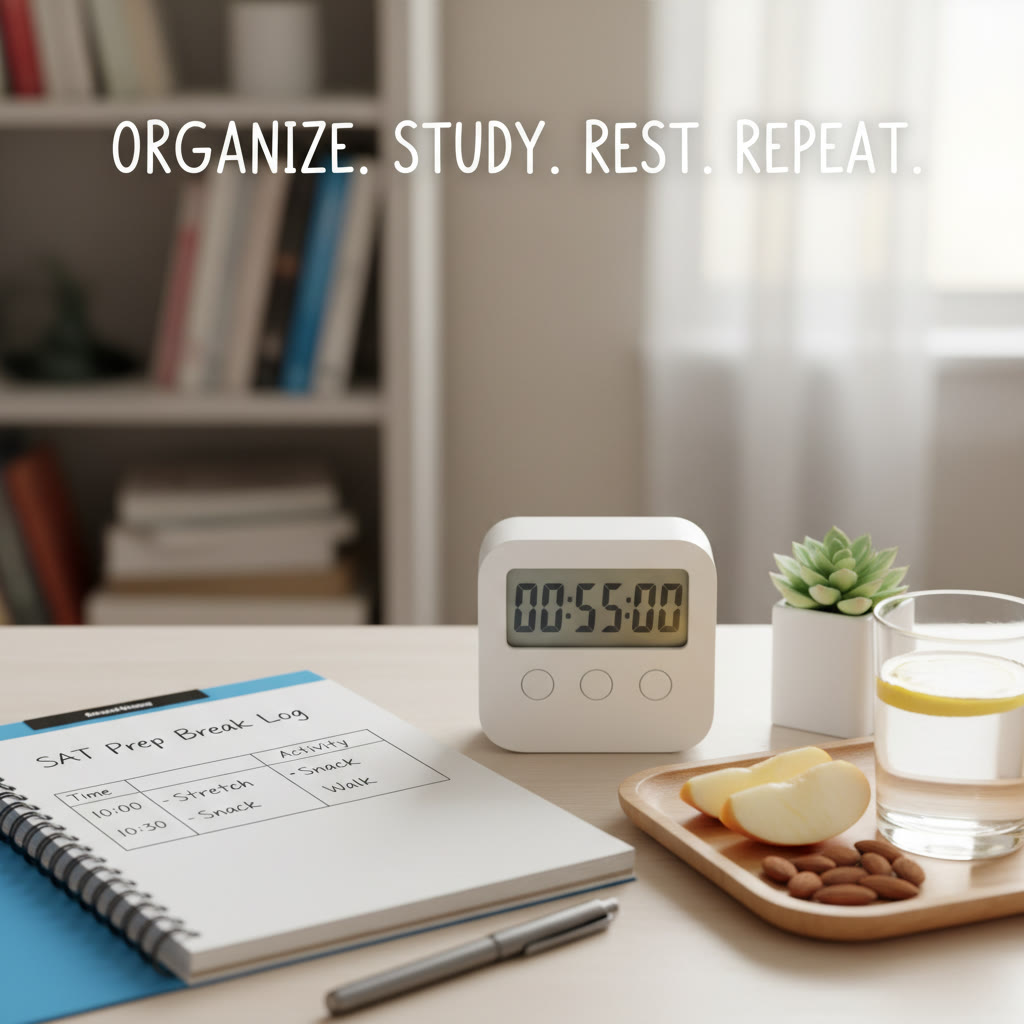Why breaks are not a waste of time (they’re the secret weapon)
When you’re prepping for the SAT, it’s tempting to think that more hours equals more improvement. But more doesn’t always mean better. Well-placed breaks can sharpen attention, reduce careless errors, and help you maintain steady pacing across a full-length practice test. Think of breaks as tune-ups for your brain: short, intentional pauses that keep your cognitive engine running smoothly.
A simple image idea

The science in plain English: what happens to your attention during long practice tests
Attention is a finite resource. Over long stretches of demanding mental work—like the reading passages and problem sets on the SAT—sustained focus decreases. Psychologists call this a vigilance decrement: accuracy and speed slowly drop as the brain tires. But attention isn’t a single switch that flips off. It’s layered: short-term focus, working memory capacity, and controlled attention all interact. Breaks help by restoring one or more of these layers.
How breaks help, step by step
- Restore alertness: Brief physical movement or a change of scenery increases blood flow and reduces drowsiness.
- Reduce cognitive fatigue: Pausing complex problem solving allows working memory to clear and reset.
- Improve monitoring: After a break, you’re more likely to notice mistakes and check your work.
- Boost motivation: Short breaks reward your brain’s effort and reduce the mental dread of an endless session.
Types of breaks and when to use them
Not all breaks are created equal. Choosing the right break depends on when you take it and what you need to recover. Below are categories that fit naturally into SAT practice.
Microbreaks (10–60 seconds)
What: A gaze shift, a few deep breaths, or standing and stretching for a few seconds.
When: After a tough question or between mini-blocks of work. These don’t interrupt flow but reset muscle tension and eye strain.
Why: They help reduce small accumulations of fatigue and keep posture from stiffening.
Short breaks (2–7 minutes)
What: A quick walk down the hallway, a splash of water on your face, a breathing exercise.
When: Every 25–40 minutes or after a dense reading or math mini-section during a practice run.
Why: Short breaks improve alertness and prevent productivity slumps without allowing the brain to fully disengage from the testing mindset.
Scheduled mid-test breaks (8–15 minutes)
What: A longer pause for a snack, restroom break, light stretching, or a change of mental task.
When: Around the halfway point of a full-length practice test or between major sections.
Why: These breaks give you time to recover from sustained effort, recalibrate pacing, and reset confidence. They mimic the real testing environment and, when used smartly, can protect second-half performance.
Restorative breaks (20–40 minutes)
What: A walk outside, a short nap, or a non-screen activity you enjoy.
When: Between practice tests or after intensive study sessions on consecutive days.
Why: These breaks allow deeper cognitive recovery and help with memory consolidation—useful after heavy learning sessions rather than in the middle of a timed practice test.
What a good practice-test break plan looks like
You want a plan that mirrors real test conditions while also preserving focus. Here’s a practical, test-friendly schedule you can tailor.
Sample full-length practice-test rhythm
- Warm-up (10–15 minutes): light review or one short diagnostic section to get the brain ready.
- Section 1: 30–50 minutes focused work depending on how you structure sections.
- Short break (3–5 minutes): stretch, sip water, blink and breathe.
- Section 2: 30–50 minutes of focused work.
- Mid-test break (8–12 minutes): snack, restroom, short movement, but avoid deep social media scrolling.
- Sections 3 and 4: finish the test with the same approach—short breaks between if your practice structure allows.
- Cooldown (10–20 minutes): review mistakes, jot down patterns to address next time.
Table: Break types, duration, benefits and do-it-now examples
| Break Type | Typical Duration | Primary Benefit | Do It Now Example |
|---|---|---|---|
| Microbreak | 10–60 seconds | Reduces eye strain, small posture resets | Look 20 feet away for 20 seconds; roll shoulders |
| Short break | 2–7 minutes | Restores alertness without losing momentum | Walk to the kitchen, drink water, do 10 squats |
| Scheduled mid-test | 8–15 minutes | Recalibrates pacing and reduces error rate | Snack (light carbs + protein), restroom, deep breaths |
| Restorative break | 20–40 minutes | Deeper recovery, memory consolidation | Short nap (10–20 min) or brisk 20-minute walk outside |
How break length affects focus: a practical comparison
Not everyone reacts the same way to breaks. Some people regain peak focus after a quick 3-minute stretch, while others need a 10-minute reset. The sweet spot depends on the intensity of the work and individual factors like sleep, nutrition, and baseline attention. The table below presents a practical illustration—hypothetical but grounded in how students commonly report changes in focus during practice tests.
| Break Length | Typical Change in Accuracy (after break) | Typical Change in Time Per Question | When It’s Best |
|---|---|---|---|
| 30 seconds | +0–1% (small) | ~0 sec change | To relieve eye strain or posture tension mid-section |
| 3–5 minutes | +1–3% | -1 to -3 sec/question (faster) | Between dense passages or after a challenging math block |
| 8–12 minutes | +2–5% | -2 to -5 sec/question | Mid-test break to sustain second-half performance |
| 20–30 minutes | +3–6% (varies) | -3 to -6 sec/question | Between full practice tests or after intense study sessions |
Note: The numbers above are illustrative averages. Your personal numbers may differ. The important takeaways are the pattern (short breaks give small, immediate boosts; mid-length breaks help maintain performance across a long session) and that very long breaks mid-test can make it harder to get back into the testing flow.
Active vs passive breaks: what to choose
Active breaks move your body or engage a different part of your brain; passive breaks are sedentary and less stimulating (think scrolling social media). For SAT practice, active breaks tend to be more restorative.
Active breaks (recommended during practice tests)
- Light stretching or a 2-minute walk—gets blood flowing and raises alertness.
- Deep-breathing exercises—helps calm test anxiety and lowers heart rate.
- Quick problem unrelated to the test (e.g., doodle or a brain teaser)—resets focus without taxing working memory related to SAT content.
Passive breaks (use cautiously)
- Sitting and scrolling on your phone—tempting but often less restorative and more distracting.
- Watching an episode or long video—can be rewarding but risks losing test mindset and costs time to refocus.
Practical tips: what to do (and not do) during breaks on practice test day
- Do hydrate and eat a light snack if you’re hungry; avoid sugary, heavy foods that might spike then crash your energy.
- Do move your body—5–10 minutes of walking or stretching can make a big difference.
- Do practice re-entry: after a mid-test break, spend 30 seconds scanning the upcoming section to mentally warm back up before diving in.
- Don’t check social media or emails—these are attention traps and often increase stress.
- Don’t do anything that requires heavy thinking about unrelated problems; math puzzles that tax working memory may not help.
- Don’t abruptly stop; give yourself a clear signal to end the break and re-engage with the test—set a visible timer.
How to personalize your break strategy
Personalization matters. Some students are morning people who need fewer breaks early on, others need more frequent resets. Here’s a quick method to find what works for you.
1. Baseline test
Run one full-length practice test mimicking real conditions but allowing you to experiment with break timing. Note errors, time per question, and how you feel during each section.
2. Tweak one variable at a time
Try changing just the length of the mid-test break on the next practice test. Compare performance and subjective focus.
3. Track and iterate
Keep a simple log: break length, activities done, perceived focus (scale 1–10), and test performance by section. Over 3–5 tests you’ll spot patterns—maybe a 10-minute walk is your sweet spot, or maybe you perform best with two 5-minute short breaks rather than a single 12-minute break.
How Sparkl’s personalized tutoring can help with break strategies
Planning breaks becomes easier when someone helps interpret your data and tailor a plan. Sparkl’s personalized tutoring offers 1-on-1 guidance and tailored study plans that factor in your stamina, pacing tendencies, and weak sections. Expert tutors can suggest break timing and activities based on your practice-test logs, and Sparkl’s AI-driven insights can point out patterns you might miss—like consistent drop-offs in accuracy after a specific section—so your break plan improves faster.
Real-world example: Sofia’s two-week experiment
Sofia was a sophomore who scored consistently well in individual practice sections but lost ground after the midpoint of full-length tests. She did a two-week experiment:
- Week 1: No mid-test break on full-length practices. Result: noticeable slip in accuracy in the third section.
- Week 2: Introduced an 8-minute mid-test break after the second section—stretching, hydration, and a 1-minute breathing routine. Result: her third-section accuracy improved by several percentage points and pacing stabilized.
She worked with a Sparkl tutor to refine her mid-test routine (short walk + protein-and-carb snack), and tracked progress to lock in a break sequence that matched her energy profile.
Common pitfalls and how to avoid them
- Overlong breaks: Taking a 30–40 minute break mid-test can make it hard to get back into rhythm. Keep mid-test breaks controlled.
- Poor break activities: Scrolling social media often reduces focus more than it helps. Choose active or restorative, low-stimulation activities.
- One-size-fits-all thinking: What helps your friend may not help you. Personalize using data from practice tests.
- Skipping the re-entry routine: After a break, give yourself 30–60 seconds to preview the next section and choose a test-taking strategy.
Putting it all together: a simple 4-week plan to build break-smart test stamina
Week 1: Baseline and microbreaks
- Take two full-length practice tests under realistic timing. No mid-test break, but use microbreaks (30–60 seconds) when needed. Log how you feel.
Week 2: Introduce short, frequent breaks
- Switch to one practice test using 3–5 minute breaks after every 30–40 minutes. Track accuracy and pacing.
Week 3: Mid-test break experiment
- Try one practice test with a single 8–12 minute mid-test break. Use an active routine: short walk, snack, 1-minute breathing. Compare results.
Week 4: Personalize and solidify
- Review logs. Choose the strategy that gave you steadier second-half performance and refine the activities. If you work with a Sparkl tutor, use this week to get a bespoke plan and AI-driven insights to fine-tune timing.
Closing thoughts: breaks as practice, not indulgence
Breaks are a form of skill practice. Learning how to pause and restart effectively is itself a test-taking skill—one that improves with deliberate practice. When you plan breaks intentionally, monitor the effects, and iterate, you build endurance, sharpen focus, and reduce careless mistakes.
Remember: what you do during the break matters almost as much as its length. Move, hydrate, breathe, and avoid attention sinks that steal minutes and focus. If you want a faster path, Sparkl’s personalized tutoring blends expert guidance with data-driven insights to help you design the break schedule that fits your brain and schedule.
A final image idea

Quick checklist to try on your next practice test
- Set a timer for both sections and planned break lengths.
- Choose active break activities: stretch, drink water, breathe.
- Avoid screens longer than 60 seconds during breaks.
- Practice a 30–60 second re-entry routine before resuming the test.
- Log your perceived focus and section scores to spot patterns.
Give your break plan three practice tests before deciding whether it’s helping. Small, consistent changes usually beat dramatic overhauls. With a little experimentation—and possibly a Sparkl tutor to speed up the process—you’ll find a rhythm that keeps your focus sharp and your scores climbing.












No Comments
Leave a comment Cancel